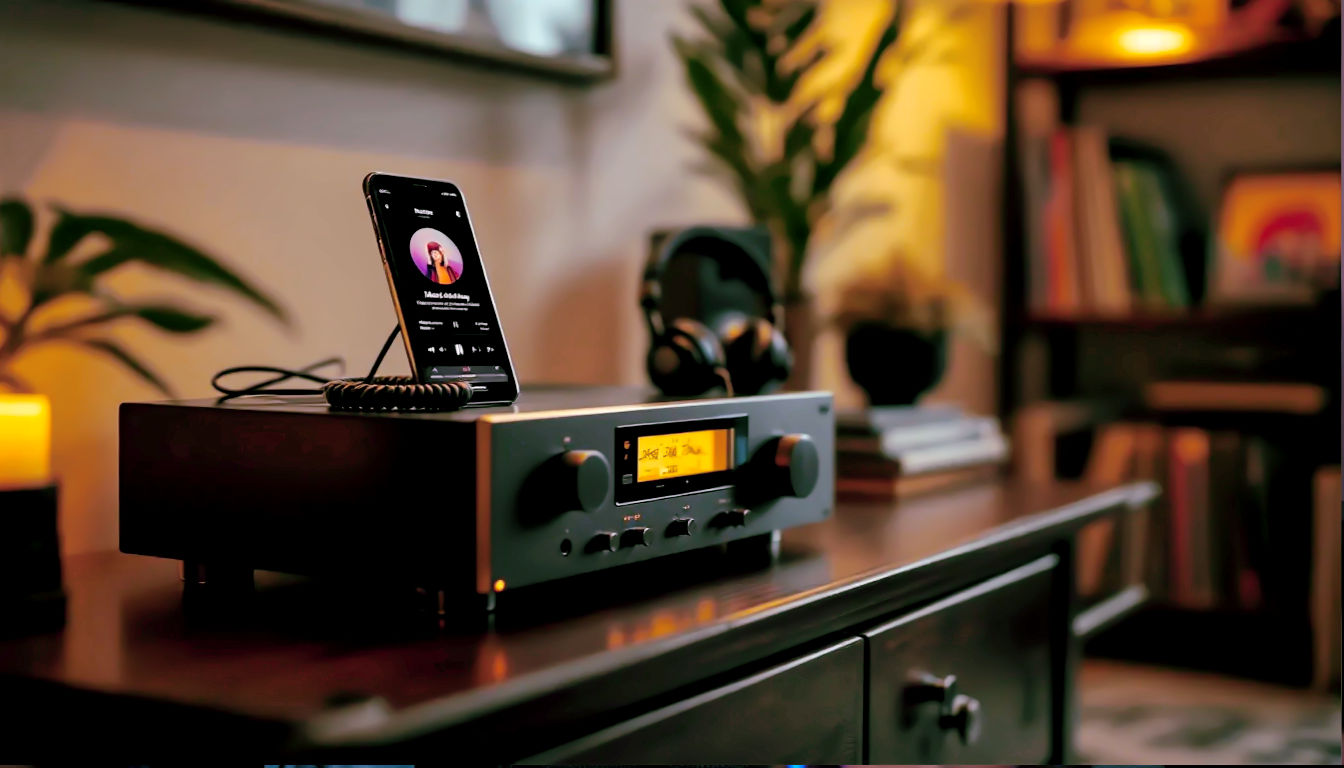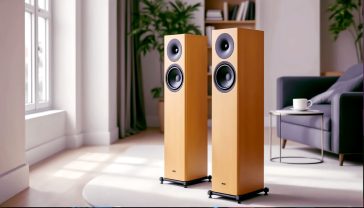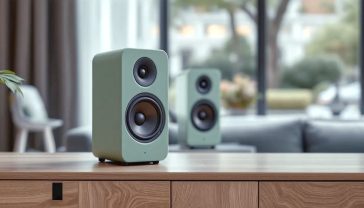The Great British Hi-Fi Puzzle: Has the Industry Given Up on Real Sound?
The Hi-Fi world seems split between cheap smart speakers and bonkers high-end gear. Has the industry lost its way? This definitive guide explores its past, present, and future.

This post may contain affiliate links. If you make a purchase through these links, we may earn a commission at no additional cost to you.
Cast your mind back for a moment. Maybe it’s to your dad’s living room in the 80s, a space dominated by two hulking wooden speakers and a mysterious silver stack of boxes with glowing dials. You weren’t allowed to touch it, of course. This was the Hi-Fi. The grown-up music machine. It had a certain weight to it, a seriousness. When you put on a record, you sat down and you listened. It was an event.
Now, think about how most of us listen to music today. It’s through tiny white earbuds on a crowded train, a smart speaker that also tells you the weather, or a slim soundbar under the TV. It’s brilliant, it’s instant, and it’s everywhere. But it’s different. The ‘event’ is gone.
This shift has left a lot of people wondering. The world of traditional Hi-Fi, with its colossal amplifiers and eye-wateringly expensive cables, can seem utterly bonkers and out of touch. At the same time, the convenience of modern audio often feels a bit… thin. Like a digital photo of a masterpiece instead of the real painting.
It begs the question: Has the Hi-Fi industry, the very group of people dedicated to perfect sound, actually given up on proper Hi-Fi? Has it lost the plot, chasing either the ultra-rich with gear that costs more than a car, or simply surrendered to the cheap and cheerful world of Bluetooth speakers?
The answer, like any good tune, is more complex and interesting than you might think. The industry hasn’t given up. It has fractured, transformed, and in some ways, found its way back to the most important person in the room: you.
What on Earth Was ‘Hi-Fi’ Anyway? The Original Dream
Before we dive in, let’s get our terms straight. ‘Hi-Fi’ is short for high-fidelity. That’s a fancy way of saying ‘highly faithful’ or ‘true to the original’. The whole point of a Hi-Fi system wasn’t to make music sound ‘better’ with booming bass or sparkly treble. The goal was to build a time machine.
Imagine a perfectly clean window. You’re not looking at the glass; you’re looking through it to the scene outside. That was the dream of early Hi-Fi pioneers: to create a system so transparent that it would disappear, leaving you in the room with the musicians. You should hear the rasp of the saxophone reed, the squeak of the pianist’s stool, the very air in the recording studio. The equipment’s job was to get out of the way.
A classic system was built from three core parts:
- The Source: This is where the music comes from. Originally, it was a turntable playing a vinyl record. Later, it was a tape deck or a CD player.
- The Amplifier: This is the engine room. It takes the tiny, delicate signal from the source and gives it enough power to drive the speakers. A good amp does this without changing the signal or adding any noise.
- The Speakers: These are the translators. They take the electrical signal from the amplifier and turn it back into the physical sound waves that travel to your ears. This is arguably the hardest job of all.
That’s it. Source, amp, speakers. A simple chain dedicated to one noble goal: recreating a moment in time.
The Golden Age: When Britain Ruled the Waves (and the Living Room)
For a few decades, roughly from the 1950s to the 1980s, Britain was the undisputed king of Hi-Fi. In workshops and small factories from Huntingdon to Glasgow, a generation of brilliant, often eccentric engineers were building some of the best audio gear the world had ever seen.
These weren’t giant, faceless corporations. They were companies built by passionate individuals. People like Peter Walker of Quad, a genius who created the legendary ESL-57 electrostatic speaker—a revolutionary panel that produced sound so clear and natural it’s still revered today. Or Harold Leak, whose amplifiers set new standards for low distortion.
This was a time when Hi-Fi was an aspirational but achievable hobby for the British middle class. You’d save up your wages, read magazines like What Hi-Fi?, and pop down to your local dealer on a Saturday to audition some speakers. Brands like Linn, Naim, Rega, Bowers & Wilkins, and KEF became household names for those in the know.
Their philosophy was built on solid engineering, not snake oil. The gear was designed to sound fantastic, last for decades, and be serviced if it broke. It was about substance. An investment in a lifetime of musical pleasure. My dad’s old Quad amplifier from the 70s still works perfectly. That’s the kind of quality they were building.
The Cracks Appear: How Convenience Became King
So where did it all go a bit pear-shaped? The first clue came in a small plastic box: the Sony Walkman. Suddenly, music was personal and portable. Fidelity took a backseat to freedom. But the real earthquake was digital.
First came the Compact Disc, which promised “perfect sound forever.” In many ways, it was a marvel of convenience. But for many audiophiles, it sounded a bit cold and sterile compared to the warmth of vinyl. Still, the industry adapted.
The true disruptor, however, wasn’t a shiny disc. It was an algorithm. The MP3.
The MP3 file format allowed you to shrink a song down to a fraction of its original size. This was revolutionary for the dial-up internet of the 90s. Websites like Napster let people share thousands of these tiny music files. It was a chaotic, legally-dubious, and thrilling time.
To make the files so small, a clever trick called lossy compression was used. Think of it like a low-resolution JPEG image. The algorithm throws away the bits of sound it thinks your ears won’t notice. For a quick listen on cheap headphones, it’s fine. But on a decent system, you can hear what’s missing. The sound is flatter, the details are gone, and the cymbals can sound like a fizzy mess.
Then came Apple and the iPod. It was a design masterpiece that put “1,000 songs in your pocket.” And just like that, the album was replaced by the playlist, and the giant living room speakers were replaced by a pair of iconic white earbuds. For a whole generation, compressed music played through basic headphones was music. “Good enough” had officially beaten “the best.”
The Great Divide: Two Paths Diverge in an Industry
Faced with a world that no longer seemed to care about ultimate sound quality, the Hi-Fi industry panicked. And in that panic, it split and ran down two very different, and very extreme, paths.
Path 1: The Rise of ‘Lifestyle’ Audio
One part of the industry saw the writing on the wall. If people wanted convenience, simplicity, and style, they’d give it to them. This led to the birth of ‘lifestyle’ audio.
The undisputed champion of this new world is Sonos. Their pitch was genius: music in every room, controlled from your phone, with no ugly wires. It just worked. Did it sound as good as a traditional Hi-Fi system of the same price? Not really. But that wasn’t the point. It was incredibly easy to live with and solved a real problem for modern homes.
This path gave us the other products that now fill our houses:
- Soundbars: Slim bars that give you better TV sound without the faff of a full surround-sound system.
- Bluetooth Speakers: Small, portable speakers you can take to the park or use in the kitchen.
- Smart Speakers: Devices like the Amazon Echo and Google Nest, where the audio quality is often secondary to the voice assistant’s ability to set a timer for your boiled egg.
These products are not inherently bad. Many are brilliantly designed. But their primary focus isn’t high-fidelity. It’s features, software, and fitting neatly into our busy lives. The original Hi-Fi dream of the ‘disappearing window’ was replaced by a desire for a ‘smart, connected home’.
Path 2: The Stratosphere of ‘High-End’ Audio
The other half of the industry had the opposite reaction. They saw the world embracing cheap, compressed audio and they doubled down on purity. They went ‘High-End’.
This is where things get a bit mad. The High-End is a world of diminishing returns, where you pay exponentially more money for tiny, sometimes imaginary, improvements in sound. It’s a world where a pair of speakers can cost more than a house in the suburbs and where a single cable connecting your amplifier to your speakers can set you back £20,000.
This is the side of the industry that gets mocked, and often for good reason. It’s filled with exotic materials, baffling jargon, and claims that can’t be backed up by science. You’ll find “audiophile-grade” network switches, special wooden knobs that “improve resonance,” and power cables thicker than a python.
This pursuit of an impossible perfection, while admirable in a way, has done huge damage to the hobby’s reputation. It has transformed an accessible passion into a status symbol for the super-rich. It created the impression that to get good sound, you had to be a millionaire with a dedicated listening room and a willingness to believe in what some call “voodoo.”
The bloke who just wanted to save up for a nice British stereo to play his records on was left out in the cold, feeling like his budget couldn’t even get him in the door.
So, Did the Industry Give Up? Not Quite. It Got Smarter.
Looking at these two extremes—cheap-and-cheerful convenience versus eye-watering, unobtainable luxury—it’s easy to think the sensible middle ground has vanished. It’s easy to conclude that, yes, the industry has given up on real Hi-Fi for real people.
But that’s not the whole story. While the giants were battling, something interesting was happening in the gaps they left behind. The industry didn’t die. It adapted, evolved, and found new, exciting ways to bring high-quality sound back to music lovers.
The Vinyl Revolution: Back to Black
The most visible comeback has been the vinyl record. Against all odds, this 70-year-old format is booming. Why? Because it offers everything that digital streaming doesn’t.
It’s tangible. You can hold it, read the liner notes, and watch it spin. It’s a ritual. You have to clean the record, carefully place the needle, and flip it over halfway through. It forces you to slow down and actively listen. It’s the ‘slow food’ movement for music. This has been a massive boost for traditional Hi-Fi companies, especially brilliant British turntable makers like Rega and Linn, who are busier than ever.
Head-Fi: The Hi-Fi You Can Wear
The second revolution has been more personal. The rise of ‘Head-Fi’—the world of high-quality headphones and the gear that drives them—has created a whole new entry point for audiophiles.
A fantastic pair of headphones can give you a level of detail and immersion that you’d need to spend thousands on speakers to match. It’s a more intimate experience. You don’t need a big living room, and you won’t annoy your family or neighbours.
For a few hundred pounds, you can buy a great pair of headphones and a small box called a DAC (Digital-to-Analogue Converter). This little gadget takes the digital signal from your laptop or phone and translates it into a clean, powerful audio signal for your headphones, bypassing the cheap, noisy electronics built into most computers. It’s the single biggest sound-per-pound upgrade you can make.
Streaming Gets Serious: Convenience Meets Quality
Perhaps the most important development is that streaming itself has grown up. For years, we were stuck with low-quality, compressed files from services like Spotify. But now, we have a choice.
Services like Tidal, Qobuz, and Apple Music now offer ‘lossless’ and ‘high-resolution’ streaming.
- Lossless is CD-quality. None of the music has been thrown away, unlike with an MP3. You get the full picture.
- High-Resolution (or Hi-Res) is even better than CD quality. It aims to give you the sound of the original master recording from the studio.
This is a game-changer. For a reasonable monthly fee, you have access to millions of albums in stunning quality. The old war between convenience and quality is finally over. You can have both.
The New Breed: The Best of Both Worlds?
Best of all, a new generation of Hi-Fi products is emerging that combines the traditional values of great sound engineering with the convenience of modern technology.
British brands are leading the charge here. Naim, a legendary maker of high-end amplifiers, created the Mu-so, a beautiful all-in-one wireless speaker that sounds absolutely phenomenal. KEF, famous for its innovative speakers, makes the LS50 Wireless II, a pair of active speakers that pack in the source, amplification, and streaming smarts into the speaker cabinets themselves. You just plug them into the wall and control them with an app.
Companies like Cambridge Audio are making integrated amplifiers like the Evo series, which combine fantastic sound with built-in high-quality streaming. This is the new face of Hi-Fi: smart, stylish, easy to use, and dedicated to brilliant sound. It’s the spirit of the golden age, updated for the 21st century.
What Does This Mean for You, the Curious Listener?
It means that this is actually the best time in history to be a music lover who cares about sound quality. You have more choice and more ways to get great sound than ever before.
You don’t need to spend a fortune or understand complex electronics. Here are a few simple starting points:
- Upgrade your source: If you use Spotify, try switching to a lossless service like Apple Music or Tidal. It’s a small change that makes a big difference.
- Invest in headphones: A good pair of wired headphones from a reputable brand will transform your listening on the go.
- Consider a DAC: A small USB DAC for your computer or phone is a cheap and incredibly effective upgrade.
- Explore the secondhand market: There is a treasure trove of brilliant vintage British Hi-Fi gear out there that can be bought for a song. It was built to last and still sounds fantastic.
- Trust your own ears: Don’t listen to forum arguments or marketing hype. Go to a dealer, listen to some different systems, and decide what sounds good to you. That’s the only thing that matters.
Conclusion: The Beat Goes On, Just in a Different Rhythm
So, has the Hi-Fi industry given up on Hi-Fi? Absolutely not.
What it has given up on is the old, rigid idea that Hi-Fi has to be a specific stack of boxes in the living room. The monolithic industry of the 70s is gone, replaced by a vibrant ecosystem of different approaches.
The mad, ultra-high-end still exists for those who can afford it. The simple, convenient lifestyle products are here to stay. But in between, a new, smarter, and more accessible vision of Hi-Fi has taken root. It lives in the vinyl revival, in the personal world of headphones, and in the brilliant new breed of smart, all-in-one systems that prove you no longer have to choose between great sound and an easy life.
The quest for high-fidelity—for that magical, transparent window into the recording studio—is alive and well. It just looks, and sounds, a little different now. The beat goes on, and it’s never been clearer.
Further Reading
For those looking to explore further, these resources are highly respected within the UK audio community:
- What Hi-Fi?: The UK’s biggest and most influential Hi-Fi magazine and website, with thousands of reviews and buying guides.
- Hi-Fi+: A magazine focused more on the high-end side of the audio world, with in-depth analysis and reviews.
- The Ear: An excellent independent UK-based Hi-Fi review website with a wide range of coverage.
- Audio Science Review: For those interested in the objective, measurement-based side of audio performance. A global site with a strong UK following.






